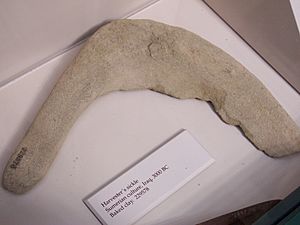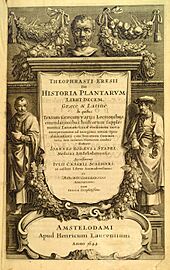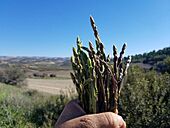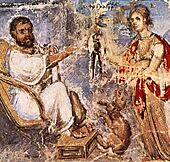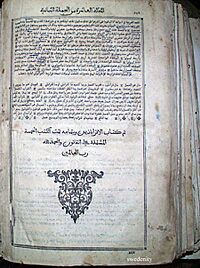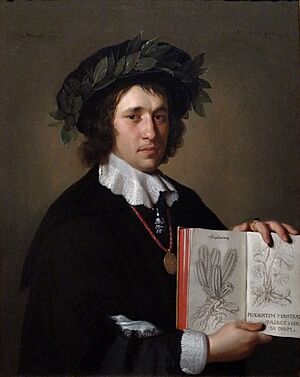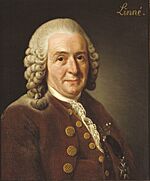History of botany facts for kids
The history of botany explores how people have learned about plants over time. Botany is the part of natural science that studies organisms traditionally seen as plants.
Early plant knowledge came from Paleolithic hunter-gatherers. They passed down information about plants they used for food, shelter, medicines, and ceremonies. The first writings showing curiosity about plants themselves (not just their uses) appeared in ancient Greece and ancient India. In ancient Greece, the teachings of Theophrastus around 350 BC are seen as the start of Western botany. In ancient India, the Vṛkṣāyurveda, by Parashara, is also considered one of the earliest texts about different parts of botany.
In Europe, botany became focused on the medicinal uses of plants for over 1000 years. During this time, old medical texts were copied into books called herbals. In China and the Arab world, knowledge about medicinal plants was kept and expanded.
The Renaissance (14th–17th centuries) in Europe brought a scientific rebirth. Botany slowly became its own science, separate from medicine and farming. Herbals were replaced by floras, which described local plants. The invention of the microscope helped people study plant anatomy. The first careful experiments in plant physiology were also done. As trade and exploration grew, many new plants were discovered. They were then carefully named, described, and classified.
Newer scientific tools have helped modern botany grow. This includes practical areas like economic botany (farming, gardening, and forestry). It also includes detailed studies of plant structure and how plants work and interact with their environment. These studies range from large-scale topics like biogeography and ecology to tiny details like cell theory, molecular biology, and plant biochemistry.
Contents
What is Botany?
Botany comes from the Greek word "Botane," meaning grass or fodder. It is one of the main parts of biology, along with zoology. Its history is linked to other sciences like chemistry, physics, and geology.
Botany can be pure science, studying plants for their own sake. Or it can be applied science, studying how humans use plants. Early natural history divided pure botany into three main areas:
- Morphology: The external form of plants.
- Classification: How plants are grouped.
- Physiology: How plants work.
Applied botany includes horticulture (gardening), forestry (managing forests), and agriculture (farming). Other areas include weed science, plant pathology (plant diseases), floristry (flower arranging), and ethnobotany (how people use plants). As technology has advanced, botany has grown to include new areas like molecular systematics, which uses molecular biology and computer science to classify plants.
Botany also has sub-disciplines that focus on specific plant groups:
- Phycology: The study of algae.
- Pteridology: The study of ferns.
- Bryology: The study of mosses and liverworts.
- Palaeobotany: The study of fossil plants.
- Mycology: The study of fungi. Fungi were once thought to be plants but are now in their own kingdom.
Ancient Plant Knowledge
Nomadic hunter-gatherers shared their knowledge about plants through stories and traditions. They knew which plants to use for food, shelter, poisons, medicines, and ceremonies. This knowledge influenced how they named and grouped plants.
Life changed greatly when settled communities appeared about 10,000 to 2,500 years ago during the Neolithic Revolution. People began to domesticate plants and animals. Written language also emerged, allowing knowledge to be passed down more easily.
How People Chose and Used Plants
During the Neolithic Revolution, plant knowledge grew a lot, especially for food and medicine. All of today's main foods were domesticated long ago. People slowly selected plant varieties that produced more food, perhaps without even knowing it. Legumes were grown everywhere, but cereals were the main diet. This included rice in East Asia, wheat and barley in the Middle East, and maize in Central and South America. By ancient Greek and Roman times, popular foods like grapes, apples, figs, and olives were listed by name in early writings.
The first known plant drawings and descriptions of impressive gardens appeared in Egypt around 3000 BC. However, the first written records about plants were not about food. They came from medical writings in Egypt, China, Mesopotamia, and India. Historians note that farming was for the poor, but medicine was for important people like shamans, priests, and physicians. These people were more likely to write down their knowledge.
Early Botanical Studies
Ancient India's Plant Wisdom
An early example of plant classification in ancient India is in the Rigveda (around 3700–3100 years ago). Plants were divided into vṛska (trees), osadhi (herbs useful to humans), and virudha (creepers). The Atharvaveda divided plants into eight classes based on their growth. Other texts like the Manusmriti and Charaka Samhitā also had detailed ways of classifying plants.
Classical Times: Greece and Rome
Ancient Greece's Plant Curiosity

Fresco in Apostolic Palace, Rome, Vatican City, by Raphael 1509–1510
Ancient Athens (6th century BC) was a busy trade center. Thinkers like Empedocles (490–430 BC) even had early ideas about how species might change over time. The physician Hippocrates (460–370 BC) focused on careful observation for healing. During this time, people started to be truly curious about plants themselves, not just their uses. Major writings about plants went beyond medicine. They covered plant geography, form, how they work, how they get food, grow, and reproduce.
Theophrastus: The Father of Botany

"Father of Botany"
Palermo Botanic Gardens
Theophrastus (around 371–287 BC) is often called the "Father of Botany." He was a student and friend of Aristotle and took over his school, the Lyceum, in Athens. The Lyceum focused on careful observation and logical thinking. Theophrastus questioned the superstitious medicine of his time. He gained much of his plant knowledge in the Lyceum garden, which likely held plants collected during Alexander the Great's military trips.
His Books: Enquiry into Plants and Causes of Plants
Theophrastus's main botany books were Enquiry into Plants and Causes of Plants. These were his lecture notes for the Lyceum. The Enquiry focused on "applied" botany. It described the forms and classification of plants and economic botany. It looked at farming techniques, like how crops relate to soil, climate, and water. He described about 500 plants in detail, including where they grew. He even recognized some plant groups that are still considered families today. Some names he used, like Crataegus, Daucus, and Asparagus, are still used.
His second book, Causes of Plants, covered plant growth and reproduction (like modern physiology). He grouped plants into "trees," "undershrubs," "shrubs," and "herbs." He also noticed other important differences. He saw that plants could be annuals (live one year), perennials (live many years), or biennials (live two years). He also noted differences between monocotyledons and dicotyledons. These notes were the first clear explanation of plant anatomy, physiology, form, and ecology. This level of detail wouldn't be seen again for 18 centuries.
Pedanius Dioscorides' Medical Text
Around 60 AD, Pedanius Dioscorides (c. 40-90 AD), a Greek doctor with the Roman army, wrote De materia medica. This book was the main text on medicinal herbs for 1500 years. It had rich medical information, describing about 600 medicinal herbs. However, its botanical content was very limited.
Ancient Rome's Farming Focus
The Romans didn't add much to the scientific foundations of botany laid by the Greeks. But they greatly improved our knowledge of practical botany, especially farming. Roman writers like Columella (4–70 AD) wrote books called De Re Rustica that explained farming principles and practices.
Pliny the Elder's Encyclopedia
The Roman writer Pliny the Elder (23–79 AD) wrote about plants in his huge work, Naturalis Historia. He often quoted Theophrastus. While he didn't have deep botanical insights, he did separate true botany from farming and medicine. By the time of the Roman Empire, about 1300 to 1400 plants had been recorded in the West.
Ancient China's Herbal Knowledge
In ancient China, lists of plants and herbal mixes for medicine go back to at least the Warring States period (481 BC-221 BC). Many Chinese writers added to this knowledge. The Chinese dictionary-encyclopedia Erh Ya (around 300 BC) described about 334 plants, mostly trees or shrubs, with names and illustrations. The Han Dynasty (202 BC-220 AD) saw important works by Zhang Zhongjing.
Medieval Plant Knowledge
Medicinal Plants of the Early Middle Ages
In Western Europe, botany made little progress for 1800 years after Theophrastus. Many early discoveries were lost. But in China, India, and the Arab world, the Middle Ages (5th to 15th centuries) were a golden age for science.
Medieval China's Botanical Works
Chinese thinkers followed a path similar to the ancient Greeks. From 100 to 1700 AD, many new books on medicinal botany were written. Scientists like Su Song and Shen Kuo wrote detailed works on natural history, focusing on herbal medicine. These books were free of superstition and myth. They had careful descriptions, names, and information on growing plants and their uses. Some even focused on ornamental plants. However, they didn't use experiments or study plant reproduction or internal structures.
Medieval India's Plant Science
In India, early plant classification systems became more scientific with the work of Parashara (c. 400 – c. 500 AD). He wrote Vṛksayurveda (the science of life of trees). He closely observed cells and leaves. He divided plants into Dvimatrka (Dicotyledons) and Ekamatrka (Monocotyledons). Dicotyledons were further grouped into categories similar to modern plant families. Important Indian works on plant physiology also appeared during this time.
Islamic Golden Age's Contributions

The period from the 9th to 13th centuries AD was the Islamic Renaissance. Islamic culture and science thrived. Greek and Roman texts were saved, copied, and expanded. New texts still focused on the medicinal uses of plants. Abū Ḥanīfa Dīnawarī (828–896 AD) is known as the founder of Arabic botany. His Kitâb al-nabât ('Book of Plants') described 637 species. It discussed plant development from germination to old age, including details of flowers and fruits. Ibn Sina (Avicenna) (c. 980–1037 AD) was another important figure. His The Canon of Medicine was a major work in medicine.
The Silk Road's Plant Exchange
After the fall of Constantinople (1453), the Ottoman Empire welcomed European visitors. This led to many new plants entering Europe along the Silk Road. In the century that followed, twenty times more plants came to Europe this way than in the previous two thousand years. Many were bulbs, and others were sought for their supposed medicinal value. Italy, especially Venice, benefited first from this new knowledge. These new plants quickly spread across Western Europe.
The Age of Herbals

In Europe during the 15th and 16th centuries, life revolved around farming. When printing with movable type and woodcut illustrations arrived, the first books published were not about farming. Instead, they were lists of medicinal plants, describing their properties. These first plant books, called herbals, showed that botany was still part of medicine. Authors of herbals were often in charge of university gardens. Most herbals were copies of older texts, especially De Materia Medica.
Early herbal authors focused on finding plants used by ancient doctors. They believed these plants must grow in Europe too. This led to confusion in naming plants. However, the need for accurate plant descriptions meant some herbals became more botanical than medicinal.

A big step forward was made by German herbal authors. They went directly to nature, described wild plants around them, and had accurate drawings made. This was the start of truly scientific plant study. Otto Brunfels's (1464–1534) Herbarum Vivae Icones (1530) had descriptions of about 47 new species with accurate pictures. Hieronymus Bock's (1498–1554) Kreutterbuch (1539) described plants he found nearby.
Valerius Cordus (1515–1544) was a pioneer in formal botanical descriptions. He detailed flowers and fruits, some anatomy (like the number of chambers in the ovary), and ovule types. He also observed pollen and different inflorescence types. His five-volume Historia Plantarum was published after his early death. In England, William Turner (1515–1568) published names, descriptions, and locations of many British plants. In Holland, Rembert Dodoens (1517–1585) included new species from the Netherlands in a scientific arrangement.
Herbals helped botany by starting the science of plant description, classification, and illustration. Until the 17th century, botany and medicine were the same. But books focusing on medicine became modern pharmacopoeias. Books that left out medicine became more botanical and turned into modern Floras (plant descriptions for regions). These were often supported by specimens in a herbarium (a collection of dried plants). This shift marked the final separation of botany from medicine.
The Renaissance and Enlightenment (1550–1800)
The Renaissance in Europe brought new interest in plants. Trade grew, and sea voyages brought botanical treasures to large public and private botanic gardens. New crops and spices from Asia and the New World became popular.
More scientific books were published. In England, groups like the Royal Society (founded 1660) and the Linnaean Society (founded 1788) helped share scientific ideas. Botanical institutions like the Jardin du Roi in Paris and Royal Botanic Gardens Kew also played a role. By the early 17th century, about 6000 plants had been described in Europe. The 18th century Enlightenment valued reason and science. New voyages led to more plant identification, naming, and illustration. This period saw a great enthusiasm for natural history, especially botany.
During the 18th century, botany was one of the few sciences considered suitable for educated women. Around 1760, with the popularity of the Linnaean system, many women studied botany. They painted plants, took classes, and collected plant specimens. Women even started publishing botanical books. However, in the early 19th century, women were again largely excluded from formal botany. Still, botany has always had a high number of female researchers, collectors, and illustrators compared to other sciences.
Botanical Gardens and Herbaria
Public and private gardens have always been important in the history of botany. Early botanical gardens were "physic gardens," holding medicinal plants described in herbals. Since they were often linked to universities, the plants were also used for study. The directors of these gardens were often important doctors and "scientific gardeners."
The first modern botanical gardens were in northern Italy. The one at Pisa (1544) was founded by Luca Ghini (1490–1556). Ghini is also credited with starting the practice of collecting pressed and dried plant specimens, called a hortus siccus (garden of dry plants). Buildings called herbaria housed these specimens. They were mounted on card with labels and stored in cupboards. This allowed them to be preserved and easily shared with other institutions, a method still used today.
By the 18th century, physic gardens became "order beds" that showed new plant classification systems. They also had to make room for the many new and beautiful plants coming from voyages of exploration.
From Herbal to Flora
Plant classification systems in the 17th and 18th centuries began to group plants based on their relationships to each other, not just to humans. This was a return to the scientific approach of Theophrastus. In England, early herbals were mostly copies or translations of European works. Thomas Johnson (1629) made the first systematic effort to collect information on British plants.
In Italy, Ulisse Aldrovandi (1522 – 1605) organized an expedition to the Sibylline mountains in 1557 and created a local Flora. He shared his findings with other European scholars, forming an early network of knowledge sharing. They began to develop Latin names for plants. Aldrovandi also founded one of the earliest botanical gardens at his university in Bologna in 1568.
In France, Clusius (1526 – 1609) traveled across Western Europe, discovering many plants. He created Floras for Spain (1576) and Austria and Hungary (1583). He was the first to suggest dividing plants into classes. In Switzerland, Conrad Gessner (1516 – 1565) explored the Swiss Alps and found many new plants. He suggested that there were groups or genera of plants, each with many species defined by similar flowers and fruits. This idea laid the groundwork for future botanists.
This approach, combined with Carl Linnaeus's new system of binomial nomenclature, led to plant encyclopedias without medicinal information. These Floras carefully described and illustrated plants in specific regions. The 17th century also saw the start of experimental botany and the use of a strict scientific method. Improvements in the microscope led to the new field of plant anatomy. Its foundations, laid by Nehemiah Grew and Marcello Malpighi, lasted for 150 years.
Botanical Exploration
New lands were opening up to European powers, and their botanical treasures were brought back to Europe for study. This was a time of brave botanical explorers, plant hunters, and gardener-botanists. Important plant collections came from:
- The West Indies (Hans Sloane (1660–1753))
- China (James Cunningham)
- The spice islands of the East Indies (George Rumphius (1627–1702))
- West Africa (Michel Adanson (1727–1806)), who also developed his own classification system.
- Canada, Hebrides, Iceland, New Zealand by Captain James Cook's chief botanist Joseph Banks (1743–1820).
Plant Classification and Form
By the mid-18th century, many plants from exploration were in gardens and herbaria. They needed to be organized. This was the job of taxonomists, who classify plants.
Plant classification systems have changed over time. They went from "artificial" systems (based on general look) to "natural" systems (showing similarities using many features). Later, "natural" systems used features to understand evolutionary relationships.
Italian doctor Andrea Caesalpino (1519–1603) taught botany at the University of Pisa. His book De Plantis (1583) described 1500 plants. He suggested classes based on the detailed structure of flowers and fruit. He was the first to try to find natural classification principles that showed overall similarities between plants. Gaspard Bauhin (1560–1624) produced two important books, Prodromus Theatrici Botanici (1620) and Pinax (1623). These organized the 6000 species known then. In Pinax, he used binomials (two-part names) and synonyms, which may have influenced Linnaeus.
Joachim Jung (1587–1657) created much-needed botanical terms that are still used today. English botanist John Ray (1623–1705) built on Jung's work to create the most detailed classification system of his time. His observations started with local plants in Cambridge. His Historia Plantarum (1682, 1688, 1704) became a step towards a world Flora. He expanded Caesalpino's natural system and defined higher classification levels more precisely. He believed all parts of plants were important for classification. Ray's system was later expanded by Pierre Magnol (1638–1715) and Joseph de Tournefort (1656–1708).
The Swedish scientist Carl Linnaeus (1707–1778) made plant cataloging much easier. He used a "sexual system" of classification, using stamens and pistils as important features. In his Species Plantarum (1753), he gave every species a binomial name. This set the standard for naming all organisms. Linnaeus's ideas dominated taxonomy for nearly a century. His system was later expanded by Bernard de Jussieu (1699–1777) and his nephew Antoine-Laurent de Jussieu (1748–1836). Michel Adanson (1727–1806) emphasized that a natural classification must consider all plant features. Adanson's method is still followed today.
By the 19th century, plant taxonomy had precise binomial names and terms. It had a classification system based on natural similarities. It also had clear ideas of family, genus, and species ranks.
Plant Anatomy: Inside Plants

In the early 18th century, botany began to move from just describing plants to doing experiments. The microscope was invented in 1590, but it wasn't until the late 17th century that lenses were good enough for major discoveries. Antony van Leeuwenhoek made amazing discoveries with his simple microscopes. Robert Hooke (1635–1703) made important general biological observations.
The foundations of plant anatomy were laid by Italian Marcello Malpighi (1628–1694) in his Anatome Plantarum (1675) and English scientist Nehemiah Grew (1628–1711) in his Anatomy of Plants (1682). These botanists studied how plants develop. They carefully observed, described, and drew how a plant grows from a seed. They also recorded how stems and wood form. This work included finding and naming parenchyma and stomata.
Plant Physiology: How Plants Work
In plant physiology, researchers focused on how sap moves and how plants absorb substances through their roots. Jan Helmont (1577–1644) found that a plant's weight increase doesn't come only from the soil. He concluded it must be related to water uptake. English scientist Stephen Hales (1677–1761) showed that plants take up water and lose it through transpiration. He also noted that "air makes a very considerable part of the substance of vegetables."
English chemist Joseph Priestley (1733–1804) discovered oxygen and that plants produce it. Later, Jan Ingenhousz (1730–1799) observed that green parts of plants absorb air and release oxygen only in sunlight. At night, they release carbon dioxide. His work laid the foundation for studying carbon fixation. He even sketched the carbon cycle in nature.
In 1804, Nicolas-Théodore de Saussure (1767–1845) showed that plant and animal respiration are similar. He also showed that carbon dioxide fixation involves water. He found that tiny amounts of salts and nutrients greatly influence plant growth.
Modern Botany: 19th Century Foundations
Around the mid-19th century, how scientists shared ideas changed. Before, people mostly read works by famous individuals. Now, research was reported in "papers" from research "schools." This encouraged questioning old ideas. Botany was greatly boosted by the first "modern" textbook, Matthias Schleiden's Principles of Scientific Botany (1849). By 1850, organic chemistry had revealed the structure of many plant parts.
The great era of plant classification had passed, but description continued. Augustin de Candolle (1778–1841) managed the botanical project Prodromus Systematis Naturalis Regni Vegetabilis. It described 58,000 species of dicotyledons in 161 families. His son Alphonse de Candolle (1806–1893) completed the work.
Plant Geography and Ecology
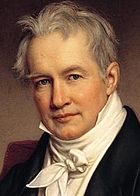
The early 19th century saw more interest in the link between climate and where plants grow. Carl Willdenow (1765–1812) studied how seeds spread and how plant groups formed. He noticed similarities between plants in North America and North Asia. German scientist Alexander von Humboldt (1769–1859) and Frenchman Aime Bonpland (1773–1858) published a huge work about their travels. Robert Brown (1773–1852) noted similarities between plants in South Africa, Australia, and India.
Eugenius Warming (1841–1924) wrote Ecology of Plants, which is considered the start of modern ecology. It included new ideas on plant communities, how they adapt, and environmental influences. This was followed by Andreas Schimper's Plant-geography upon a physiological basis (1898).
Plant Anatomy: Cells and Tissues
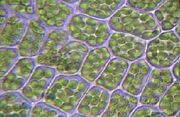
In the 19th century, German scientists led the way in understanding plant structure and life cycle. After microscope improvements, Charles Mirbel (1776–1854) published his Traité d'Anatomie et de Physiologie Végétale in 1802. Johann Moldenhawer (1766–1827) described techniques for separating plant cells. He identified vascular and parenchymatous tissues, and observed cells in the cambium (which makes tree rings). He found that stomata (pores on leaves) were made of pairs of cells.
Studies on the stele (central part of root/stem) were done by Carl Sanio (1832–1891). Hugo von Mohl (1805–1872) summarized anatomy work up to 1850. Studies also began on the origins of the carpel and flower.
Water Movement in Plants
The mystery of how water and nutrients move through plants remained. Physiologist Von Mohl studied solute transport and how roots take up water. He used ideas like cohesion, transpirational pull, and root pressure. Stephen Hales's work was continued by Jan Ingenhousz, who discovered the importance of light for oxygen production.
Stephen Hales's Vegetable Staticks (1727) was a key work. He showed that plants take up water and lose it through transpiration, and that this is affected by the environment. He also noted that "air makes a very considerable part of the substance of vegetables."
Cytology: The Study of Cells
The cell nucleus was discovered by Robert Brown in 1831. The idea that all organisms are made of cells, and each cell has all the characteristics of life, came from botanist Matthias Schleiden and zoologist Theodor Schwann (1810–1882).
From 1870 to 1880, it became clear that cell nuclei always come from other nuclei. In 1882, Flemming observed chromosomes splitting during cell division. By the early 20th century, it was found that the number of chromosomes in a species is constant. With this, and the discovery by Eduard Strasburger that reproductive cells have half the number of chromosomes (meiosis), the field of heredity opened up. By 1926, Thomas Morgan outlined a theory of the gene. The study of cells, or cytology, became firmly established.
Later, Gregor Mendel's (1822–1884) laws of plant heredity, first published in 1866, were rediscovered. This opened up plant genetics. The role of polyploidy and hybridization in speciation (forming new species) was explored. It became clear that interbreeding populations were the unit of change in biology.
Plant Form and Evolution
Until the 1860s, people believed species never changed. But strange fossils and geological formations needed explanation. Charles Darwin's Origin of Species (1859) introduced the theory of descent with modification (evolution). Phylogeny (the study of evolutionary relationships) became a new principle. Classifications began to reflect evolutionary relationships, not just similarities.
German writer Johann Wolfgang von Goethe (1749–1832) had interests in botany. In Die Metamorphose der Pflanzen (1790), he created a theory of plant morphology (he coined the word "morphology"). He linked comparative morphology with phylogeny. His theory encouraged discussion and research on the origin and function of flower parts.
How Plants Make Food (Photosynthesis)
At the start of the 19th century, the idea that plants could make almost all their tissues from air had not yet emerged. The energy part of photosynthesis (capturing sunlight in carbon bonds) was first explained in 1847 by Mayer. Chlorophyll was named in 1818, and its chemistry was slowly figured out.
The process of photosynthesis remained a mystery until the mid-19th century. In 1862, Sachs noted that starch formed in green cells only in light. In 1882, he confirmed that carbohydrates are the starting point for all other organic compounds in plants. The link between chlorophyll and starch production was made in 1864. But tracing the exact biochemical path of starch formation didn't begin until around 1915.
Nitrogen Fixation
Nitrogen fixation (plants taking up nitrogen from the air with help from soil microorganisms) was discovered later. This had to wait for advances in chemistry and bacteriology in the late 19th century. Then, in the early 20th century, how protein and amino-acids are made was explained. With this knowledge, the global nitrogen cycle could be outlined.
20th Century Botany

20th-century science built on the strong foundations of the 19th century. A much larger group of researchers quickly expanded botanical knowledge at all levels, from molecules to global plant ecology. There was now an understanding of how biological structure and function are connected at the cellular and biochemical levels. Botanical progress was closely linked to advances in physics and chemistry. The biggest advances in the 20th century were about understanding molecular organization.
By 1910, experiments using labeled isotopes helped explain plant biochemical pathways, leading to gene technology. Research funding also became available from agriculture and industry.
Molecules and Life Processes
In 1903, Chlorophylls a and b were separated using chromatography. Through the 1920s and 1930s, biochemists like Hans Krebs began to map out the main metabolic pathways of life. Between the 1930s and 1950s, it was found that ATP in mitochondria is the source of cellular energy. The reactions of photosynthesis were also gradually revealed. In 1944, DNA was extracted for the first time.
Plant hormones, or "growth substances," were also discovered. These include auxins (1934), gibberellins (1934), and cytokinins (1964). The effects of photoperiodism (how day and night length control plant processes like flowering) were also understood.
After Mendel's laws were established, the gene-chromosome theory of heredity was confirmed. August Weismann identified chromosomes as the hereditary material. He also observed the halving of chromosome numbers in reproductive cells (meiosis). In the 1920s and 1930s, population genetics combined evolution theory with Mendelian genetics to create the "modern synthesis." By the mid-1960s, the molecular basis of metabolism and reproduction was firmly established through molecular biology.
Genetic engineering, inserting genes into a host cell, began in the 1970s with recombinant DNA techniques. Its use in agricultural crops followed in the 1990s. It became possible to identify organisms using molecular "fingerprinting" and to estimate past evolutionary changes using "molecular clocks."
Computers, Electron Microscopes, and Evolution

Better experimental tools and scientific instruments opened new fields. In 1936, Alexander Oparin (1894–1980) showed how organic matter might have formed from inorganic molecules. In the 1960s, it was found that Earth's earliest life-forms, like cyanobacteria (known as stromatolites), date back 3.5 billion years.
Mid-century electron microscopy allowed scientists to see the "ultrastructure" of matter, taking anatomy to a new level.
New classification systems for the plant kingdom were created by botanists like August Eichler. A huge 23-volume work, Die natürlichen Pflanzenfamilien, was published by Adolf Engler and Karl Prantl from 1887 to 1915. Taxonomy based on overall form was now supported by features seen through pollen morphology, embryology, anatomy, cytology, and molecular biology. Computers helped analyze large data sets for numerical taxonomy. The focus on truly natural phylogenies led to cladistics and phylogenetic systematics.
In 1998, the Angiosperm Phylogeny Group published a phylogeny of flowering plants based on DNA sequences. This new molecular systematics helped answer questions about the earliest evolutionary branches of angiosperms (flowering plants). The exact relationship of fungi to plants had been unclear. Molecular analysis in the 1980s-90s showed that fungi diverged from other organisms about 1 billion years ago. This was enough reason to put them in their own kingdom, separate from plants.
Biogeography and Ecology
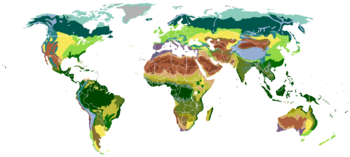
The publication of Alfred Wegener's (1880–1930) theory of continental drift in 1912 boosted the study of biogeography (where plants grow). In the 1930s, ecology developed important ideas like plant communities, succession (how communities change), and energy flows. From 1940 to 1950, ecology became its own field. Eugene Odum (1913–2002) developed many concepts of ecosystem ecology, focusing on relationships between groups of organisms. Building on earlier work, Nikolai Vavilov (1887–1943) from 1914 to 1940 described the geography, origins, and evolutionary history of important economic plants.
Images for kids
See also
 In Spanish: Historia de la botánica para niños
In Spanish: Historia de la botánica para niños
- International Botanical Congress
- History of plant systematics
- Botanical illustration
- History of phycology
- List of botanists
- List of botanists by author abbreviation


